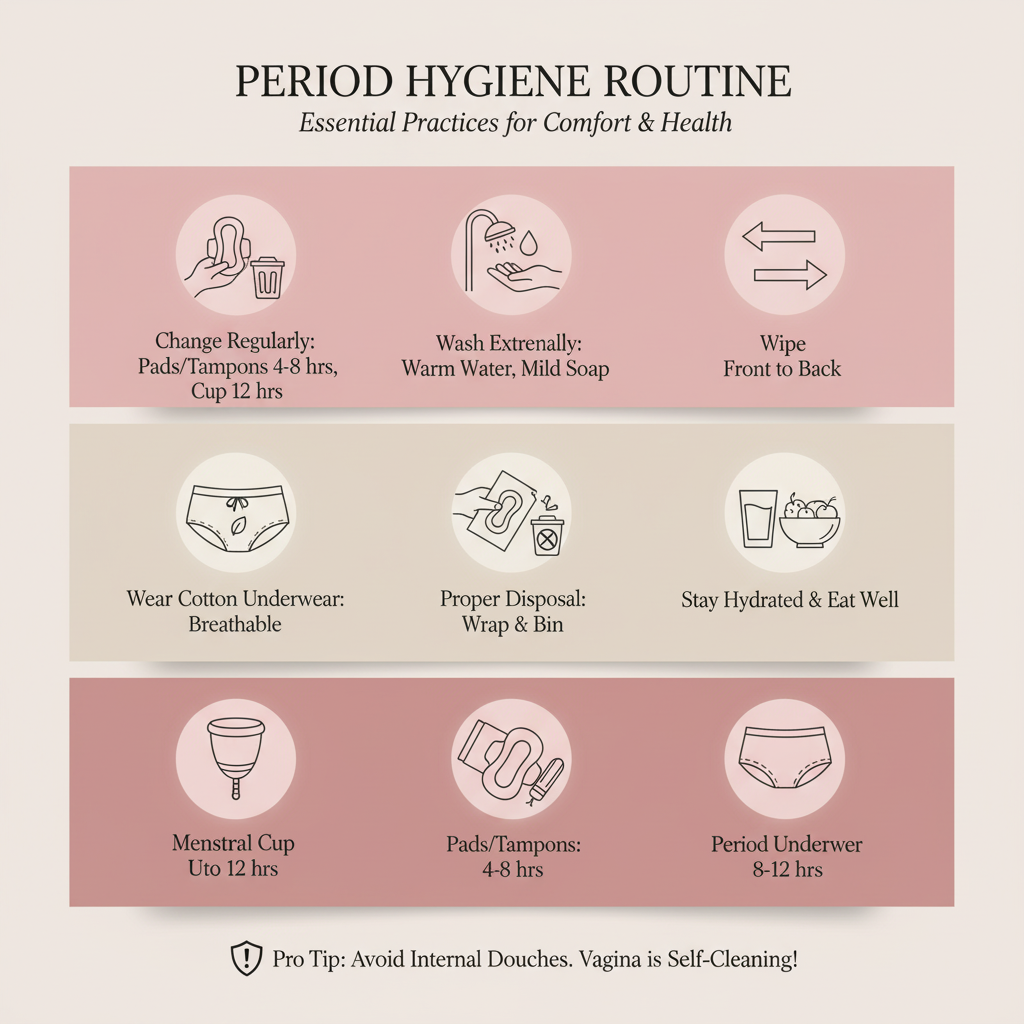Period Hygiene Routine

Maintaining a proper hygiene routine during menstruation promotes comfort, prevents infections, and supports overall reproductive health. This guide outlines practical steps for managing period flow safely and effectively. Always consult a healthcare provider if you experience unusual symptoms, such as persistent irritation or abnormal discharge, to address potential health concerns.
1. Choose Appropriate Menstrual Products
-
Options:
-
Pads: Disposable or reusable cloth pads, changed every 3–6 hours depending on flow (more frequently on heavy days).
-
Tampons: Change every 4–8 hours, choosing the lowest absorbency needed for your flow to reduce risk of toxic shock syndrome (TSS).
-
Menstrual Cups: Reusable silicone or rubber cups, emptied and cleaned every 6–12 hours.
-
Period Underwear: Absorbent, reusable underwear, changed daily or as needed for lighter flow.
-
-
Selection Tips:
-
Match product absorbency to flow intensity (e.g., light, regular, or heavy).
-
Alternate products (e.g., pads at night, tampons during the day) for comfort and convenience.
-
For reusable products, wash thoroughly with mild soap and water, and dry completely to prevent bacterial growth.
-
-
Purpose: Ensures effective flow management while minimizing discomfort and infection risk.
2. Maintain Personal Cleanliness
-
Daily Hygiene:
-
Shower or bathe daily with warm water and mild, unscented soap to clean the genital area gently.
-
Wash externally only, avoiding douching or harsh cleansers that disrupt vaginal flora.
-
Pat dry with a clean towel to prevent moisture buildup, which can promote bacterial or yeast infections.
-
-
During Changes:
-
Wash hands before and after changing pads, tampons, or menstrual cups to prevent contamination.
-
Wipe front to back with toilet paper or unscented wipes to avoid transferring bacteria from the anus to the vagina.
-
-
Purpose: Reduces the risk of infections like bacterial vaginosis or urinary tract infections (UTIs).
3. Change Menstrual Products Regularly
-
Frequency:
-
Pads: Change every 3–6 hours, or sooner if soaked on heavy days.
-
Tampons: Change every 4–8 hours, never leaving in longer than 8 hours to reduce TSS risk.
-
Menstrual Cups: Empty and rinse every 6–12 hours, boiling between cycles for sterilization.
-
Period Underwear: Change daily or more often for heavy flow, washing thoroughly after use.
-
-
Nighttime:
-
Use a high-absorbency pad or period underwear at night for longer protection.
-
Consider placing a towel under your hips to prevent leaks during sleep.
-
-
Purpose: Prevents odor, leakage, and infections by keeping the genital area clean and dry.
4. Track Hygiene Routine and Symptoms
-
Action: Use a notebook, calendar, or digital reminder system to log:
-
Frequency of product changes and type used (e.g., “Day 2: changed pad 4 times, moderate flow”).
-
Hygiene practices (e.g., daily showers, hand washing).
-
Symptoms like irritation, itching, or unusual discharge that may indicate an issue.
-
-
Tracking Tips:
-
Note any discomfort (e.g., skin irritation from pads) or product performance (e.g., leaks) to adjust choices.
-
Track for 3–6 cycles to establish a routine and identify patterns.
-
-
Purpose: Helps maintain consistency and detect hygiene-related issues early.
5. Manage Odor and Comfort
-
Odor Control:
-
Normal menstrual blood has a mild odor, but strong or foul odors may indicate infection.
-
Change products regularly and maintain daily hygiene to minimize odor.
-
Avoid scented pads, tampons, or sprays, as they can cause irritation or allergic reactions.
-
-
Comfort Tips:
-
Wear breathable, cotton underwear to reduce moisture and irritation.
-
Choose loose-fitting clothing to improve airflow and comfort during heavy flow days.
-
-
Purpose: Enhances comfort and confidence while reducing infection risk.
6. Dispose of Products Safely
-
Disposable Products:
-
Wrap used pads or tampons in toilet paper or their wrapper and dispose in a lined trash bin.
-
Avoid flushing tampons or pads, as they can clog plumbing.
-
-
Reusable Products:
-
Rinse menstrual cups or cloth pads in cold water before washing with mild soap. Boil cups between cycles for sterilization.
-
Store clean, dry reusable products in a breathable bag or container until the next cycle.
-
-
Purpose: Ensures hygienic disposal and prevents environmental or plumbing issues.
7. Watch for Warning Signs
-
Symptoms to Monitor:
-
Persistent itching, redness, or irritation in the genital area, which may indicate an allergic reaction or infection.
-
Foul-smelling discharge, unusual vaginal odor, or burning during urination, suggesting possible bacterial vaginosis or yeast infection.
-
Fever, dizziness, or flu-like symptoms with tampon use, which could indicate toxic shock syndrome (TSS).
-
-
Action: Consult a healthcare provider immediately if you experience these symptoms or if flow changes significantly (e.g., soaking a pad/tampon every 1–2 hours).
-
Purpose: Ensures timely intervention for potential infections or complications.
8. Support Overall Health
-
Nutrition: Eat iron-rich foods (e.g., leafy greens, lean meats) to replenish blood loss and maintain energy, especially during heavy periods.
-
Hydration: Drink 8–10 cups of water daily to reduce bloating and support overall health.
-
Stress Management: Practice 5–10 minutes of relaxation techniques (e.g., deep breathing, meditation) to ease stress-related symptoms like cramping.
-
Purpose: Supports reproductive health and enhances comfort during menstruation.
Benefits
-
Infection Prevention: Proper hygiene reduces the risk of vaginal or urinary infections.
-
Comfort and Confidence: A consistent routine minimizes discomfort and odor, improving daily well-being.
-
Health Awareness: Tracking hygiene and symptoms helps detect issues early for timely medical care.
Practical Tips
-
Hygiene Kit: Keep a small bag with extra pads, tampons, or a menstrual cup, unscented wipes, and hand sanitizer for on-the-go changes.
-
Product Rotation: Alternate between products (e.g., cups during the day, pads at night) to find the most comfortable combination.
-
Tracking Tools: Log hygiene practices and symptoms in a simple journal (e.g., “Day 3: changed tampon every 5 hours, mild irritation noted”). Include details for provider discussions.
-
Skin Care: Apply a fragrance-free moisturizer (if needed) to prevent chafing from pads, but avoid the vaginal opening.
-
Laundry for Reusables: Wash cloth pads or period underwear in cold water first, then use a gentle detergent in a regular cycle. Air-dry to maintain fabric integrity.
-
Emergency Preparedness: Keep extra menstrual products and clean underwear at work or in your car for unexpected periods.
Actionable Next Steps
-
Today: Choose a tracking tool and prepare a hygiene kit with menstrual products and cleaning supplies.
-
This Week: Begin logging product changes, hygiene practices, and any symptoms during your next period.
-
Next 3–6 Cycles: Establish a consistent hygiene routine and monitor for discomfort or irregularities.
-
Ongoing: Consult a healthcare provider if you notice warning signs like irritation, unusual discharge, or severe symptoms.
Related Articles

Week 35 - Preparation for Birth

Cycle Self-Care Rituals

Week 17 - Fat Layers Develop

Week 23 - Skin Thins

Week 34 - Immune System Develops

Week 36 - Descent into Pelvis

Revolutionizing Menstrual Health Management

Week 4 - Neural Tube Development